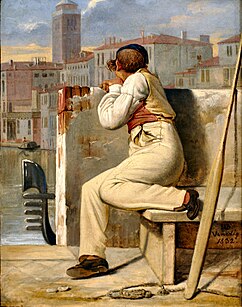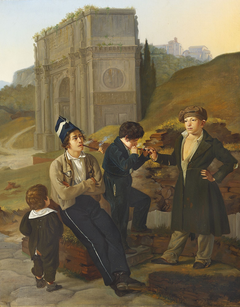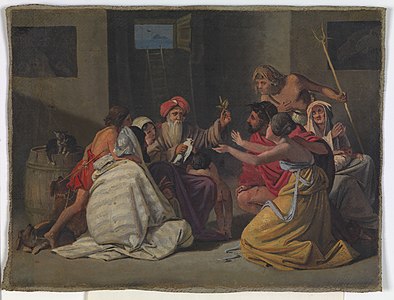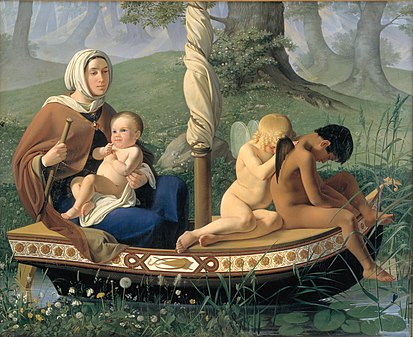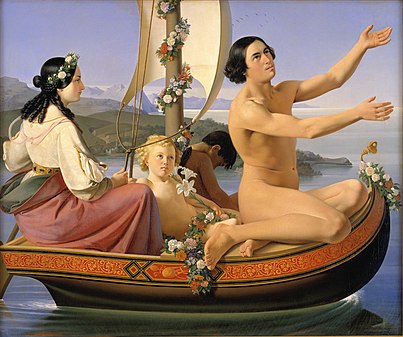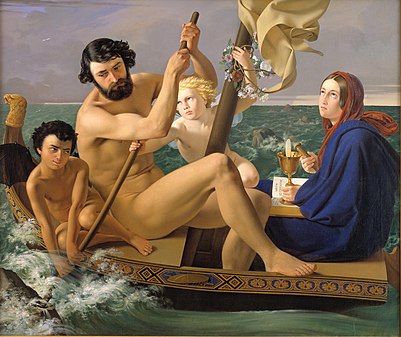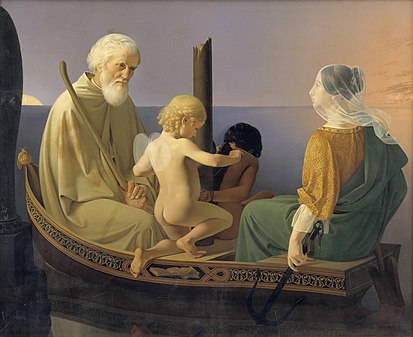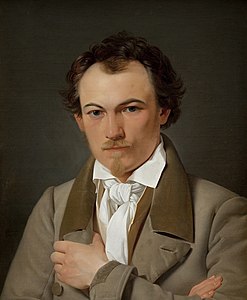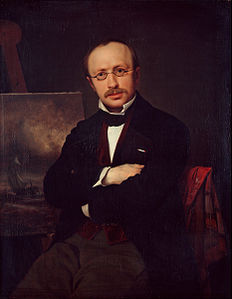
Christen Schiellerup Købke was a Danish painter, and one of the best-known artists from the Golden Age of Danish Painting.

Friedrich Wilhelm, Duke of Schleswig-Holstein-Sonderburg-Glücksburg was a German-Danish prince and officer who was the Duke of Schleswig-Holstein-Sonderburg-Beck from 1816 to 1825, and the Duke of Schleswig-Holstein-Sonderburg-Glücksburg from 1825 to 1831. Friedrich Wilhelm is the progenitor of the House of Glücksburg.

Christoffer Wilhelm Eckersberg was a Danish painter. He was born in Blåkrog in the Duchy of Schleswig. He went on to lay the foundation for the period of art known as the Golden Age of Danish Painting, and is referred to as the "Father of Danish painting".

Wilhelm Ferdinand Bendz was a Danish painter mainly known for genre works and portraits which often portray his artist colleagues and their daily lives. He was one of the most talented artists in the successful generation of painters who studied under Christoffer Wilhelm Eckersberg but died early and has therefore left a relatively small oeuvre.

Jens Juel was a Danish painter, primarily known for his many portraits, of which the largest collection is on display at Frederiksborg Castle. He is regarded as the leading Danish portrait painter of the 18th century.

Martinus Christian Wesseltoft Rørbye was a Danish painter, known both for genre works and landscapes. He was a central figure of the Golden Age of Danish painting during the first half of the 19th century.
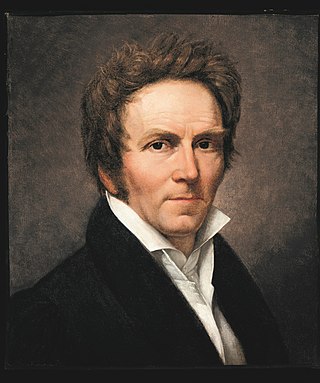
Johan Ludwig Gebhard Lund was a Danish painter, born in Kiel, Duchy of Holstein, to master painter Hans Giewert Lund and his wife Maria Magdalena Christina Bremer. An adherent of romanticism, he is known for his history paintings.

Peter Christian Thamsen Skovgaard was a Danish national romantic landscape painter. He is one of the main figures associated with the Golden Age of Danish Painting. He is especially known for his large scale portrayals of the Danish landscape.

Niels Laurits Andreas Høyen is considered to be the first Danish art historian and critic. He promoted a Danish nationalistic art through his writings and lectures, and exerted a far reaching effect on contemporary artists. His work in various cultural institutions helped steer the development of Danish art during the mid-19th century.

Johan Thomas Lundbye was a Danish painter and graphic artist, known for his animal and landscape paintings. He was inspired by Niels Laurits Høyen's call to develop nationalistic art through depictions of Denmark's characteristic landscapes; the historical buildings and monuments, and the country's simple, rural people. He became one of his generation's national romantic painters, along with P. C. Skovgaard and Lorenz Frølich, to regularly depict the landscape of Zealand.
The Danish Golden Age covers a period of exceptional creative production in Denmark, especially during the first half of the 19th century. Although Copenhagen had suffered from fires, bombardment and national bankruptcy, the arts took on a new period of creativity catalysed by Romanticism from Germany. The period is probably most commonly associated with the Golden Age of Danish Painting from 1800 to around 1850 which encompasses the work of Christoffer Wilhelm Eckersberg and his students, including Wilhelm Bendz, Christen Købke, Martinus Rørbye, Constantin Hansen and Wilhelm Marstrand, as well as the sculpture of Bertel Thorvaldsen.
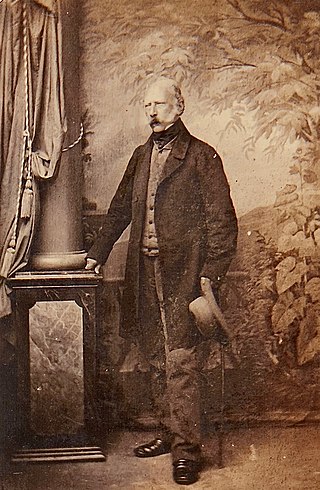
Christian August II, Duke of Schleswig-Holstein-Sonderburg-Augustenburg, commonly known as Christian, Duke of Augustenborg, was a Danish/German prince and statesman. During the 1850s and 1860s, he was a claimant to first duke of the whole provinces of Schleswig and Holstein, and a candidate to become king of Denmark following the death of King Frederick VII. He was the father-in-law of Princess Helena and the paternal grandfather of Augusta Victoria, German Empress and wife of Kaiser Wilhelm II.
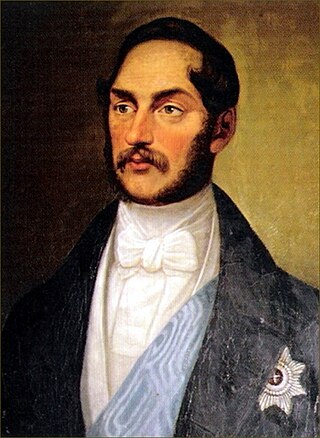
Karl, Duke of Schleswig-Holstein-Sonderburg-Glücksburg was Duke of Schleswig-Holstein-Sonderburg-Glücksburg from 1831 to 1878. Karl was the eldest son of Friedrich Wilhelm, Duke of Schleswig-Holstein-Sonderburg-Glücksburg, and Princess Louise Caroline of Hesse-Kassel and an elder brother of Christian IX of Denmark.

Albert Küchler, O.F.M., also known as Peter of Copenhagen, was a Danish painter associated with the Danish Golden Age. He mainly painted genre works and portraits. He was highly esteemed by his contemporaries but is little known today. Later in life, he converted to Catholicism and became a member of the Order of Friars Minor

Hans Jørgen Hammer was a genre, landscape, and portrait painter and printmaker of the Golden Age of Danish painting. In addition, he served for eleven years as a military officer.

Niels Simonsen was a Danish painter, lithographer and sculptor.
Friedrich Bernhard Westphal was a German-Danish genre painter and illustrator. He was also known by his nickname Fritz Westphal.

A Group of Danish Artists in Rome is an 1837 oil painting by the Danish Golden Age artist Constantin Hansen. The work depicts a group of Danish painters, architects, and other artists in a Roman hotel room; those painters depicted are Hansen himself, Michael Gottlieb Bindesbøll, Martinus Rørbye, Wilhelm Marstrand, Albert Küchler, Ditlev Blunck, and Jørgen Sonne.
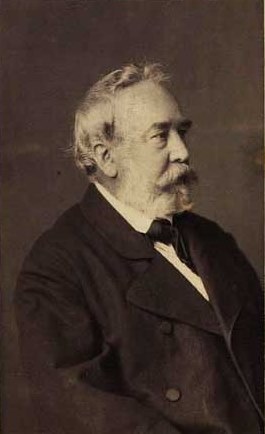
Carl Edvard Sonne was a Danish printmaker. His work consisted exclusively of reproductions of works by other artists, especially genre paintings, which reached a large audience through Kunstforeningen. He was the brother of painter Jørgen Sonne.
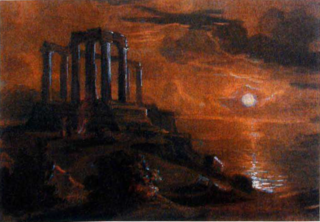
Karl Ross was a German painter. He is most known for his paintings of classical landscapes. He was the brother of the classical archaeologist Ludwig Ross, and executed several of his paintings during travels with Ludwig and other companions throughout Greece.


